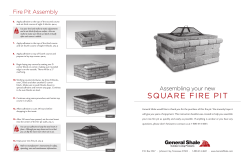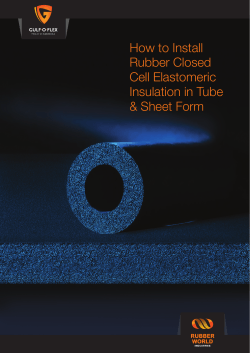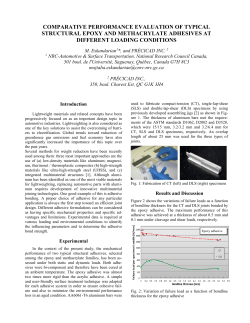
Use of flexible polymers (adhesives) in the design of aerospace applications F KADIOGLU
Use of flexible polymers (adhesives) in the design of aerospace applications F KADIOGLU University of Turkish Aeronautical Association 25-26/09/2014 Frame of the presentation Why polymer matrix composite materials? Some basic information about adhesives & adhesive joints Two examples Why polymer matrix composite materials? Polymer Matrix Composite Materials Composites can be very strong and stiff, yet very light in weight, so ratios of strength-to-weight and stiffness-to-weight are several times greater than steel or aluminum Fatigue properties are generally better than for common engineering metals Toughness is often greater too Composites can be designed that do not corrode like steel Possible to achieve combinations of properties not attainable with metals, ceramics, or polymers alone Disadvantages and Limitations of Composite Materials Properties of many important composites are anisotropic - the properties differ depending on the direction in which they are measured – this may be an advantage or a disadvantage Many of the polymer-based composites are subject to attack by chemicals or solvents, temperature, humidity, just as the polymers themselves are susceptible to attack Composite materials are generally expensive Manufacturing methods for shaping composite materials are often slow and costly Applications Joining techniques of composites Rivet joint Adhesive joint Types of adhesive joints (a) Single Lap (b) Double Lap Metal Cfrp Metal (c) Butt Strap (d) Step (e) Bevel (f) Scarf Cfrp Definition of an adhesive An adhesive is defined as a substance capable of holding materials together by surface attachment. Structural Adhesives: usually reckoned to be those with a high strength (50 MPa and upwards) and (these days), a strain to failure of at least 10% in tension, and which usually have a tensile modulus of 2 GPa or so Flexible Adhesives: significantly less stiff, less strong, but much more ductile Advantages Joining dissimilar materials (dissimilar thin sheets and foils) Improvement in the appearance of the finished assembly by the elimination of irregular surface the fabrication of complex shapes Relatively uniform distributions of stress over the entire bonded area Improving fatigue resistance and giving good vibration damping ……… Disadvantages residual stresses in bonded joints (different thermal expansion) curing requirement sensitivity to peel loading, creep etc… degradation of the adhesive caused by heat, cold, chemical agents, radiation, and bio-deterioration not easily dismantled for repair or salvage assessment of bond quality The most important parameter! Surface pretreatment Chemical solutions to clean the surfaces Surface modification methods Loading types Good (shear) Poor (tension) Worst (cleavage) Failure mechanisms Adhesive failure Cohesive failure Poor surface treatment (failure in adhesive-adherend interlayer) able to get mechanical performance of an adhesive (failure in adhesive or in adherend) Adhesive-Cohesive failure usually due to the adherend yielding Design- Predictions Analytical Analysis Volkersen’s elastic adherend model Goland & Reissner bending model Numerical Analysis FEM (the most effective tool) Problems with analytical analysis Volkersen’s elastic adherend model Goland & Reissner bending model P P x ð Shear Stress x Transverse (or Peel) Stress ð Reality and three-dimensional stress analysis differential straining of the adherends causing a shear stress distribution in the adhesive which is a maximum at the ends of the overlap (Volkersen (1938)) offset loading of the lap joint which causes the loaded adherend to bend adjacent to the overlap region (Goland and Reissner (1944)) end effects such as the adhesive free surface, spew, and material and geometric discontinuities which all affect the stresses at the overlap ends (Crombe and Adams (1981)) Poisson’s ratio effects adherend plasticity Some precautions to reduce the stress concentrations at the ends Metal Cfrp Metal Cfrp Examples A Structural Adhesive: AV119, A Flexible Adhesive: 9245 one-part epoxy, manufactured by Ciba Polymers. cured at 120 C for an hour according to manufacturer’s instructions. Structural Bonding Tape (SBT), mixure of acrylic and epoxy, cured at 140 C for 45 minutes according to the manufacturer’s instructions. Mechanical behavior Shear Curve Tensile Curve 80 70 Shear Curve Tensile Curve 60 40 20 30 Stress MPa Stress MPa 25 50 20 10 15 10 0 0 0,1 0,2 0,3 0,4 0,5 0,6 5 Strain 0 0 Structural Adhesive AV119 0,5 1 1,5 Strain Flexible Adhesive SBT 2 Lap shear performance in quas-static loading under tensile loading 1.6 mm Adhesive Layer (0.4 mm) F 63.5 mm Overlap Length Stress distributions in the adhesive layers under tensile loading SBT (Flexible Adhesive) AV119 (Structural Adhesive) 80 25 70 20 60 50 SX 10 SY S XY 5 S E QV 0 0 5 10 15 20 25 S tres s MP a S tres s MP a 15 40 SX 30 SY 20 S XY 10 S E QV 0 -2 -10 1 4 7 10 13 16 -20 -5 Ove rla p L e ng th m m Ove rla p L e ng th m m 19 22 25 Comparison of results from tensile loading Mild steel adherends 14 60 12 50 10 8 SBT AV119 6 4 Failure Load kN Failure Load kN Hard steel adherends 40 AV119 20 2 10 0 0 0 20 40 60 Overlap Length mm 80 100 120 SBT 30 0 20 40 60 Overlap Length mm 80 100 120 A broken adherend from the tensile test Lap shear performance in quas-static loading under bending loading P P A D C B Spew fillet Adhesive layer 30 20 25 20 All dimensions in mm 30 Stress distributions in the adhesive layers under bending loading SBT AV119 80 25 Stress in the adhesive layer, MPa Stress in the adhesive layer, MPa 70 20 15 10 5 60 50 40 30 20 10 0 0 0 5 10 15 Overlap length, m m 20 25 30 0 5 10 15 Overlap length, m m 20 25 30 Comparison of curves (results) from bending loading 1800 1600 1400 Load N 1200 1000 SBT 800 AV119 600 400 200 0 0 5 10 15 20 Crosshead Displacement mm 25 30 A broken adherend UTS= 2000 MPa SBT stress-strain variation curve with strain-rate variation at room temperature using a laser extensometer 30 1.93 /min 25 True Stress, MPa 0.25 /min 0.057 /min 20 15 10 5 0 0 20 40 60 True Strain (%) 80 100 120 Comparison of quasi-staic and impact test 35 Shear Stress MPa 30 Impact test 25 20 15 10 QuasStatic T orsion test 5 0 0 0,5 1 Shear Strain 1,5 2 Vibration set-up dynamic properties of materials Oscilloscope Signal Generator Digital Multimeter Power Amplifier Analogue Voltmeter Microphone Specimen Bracket with Cotton Supports Foam Foam Shaker Damping performance of the adhesives Adhesive Thickness = 0.45 mm 0.025 0.022 The SLJ Los factor 0.02 0.015 0.01 0.005 0.001 0 SBT AV119 Adhesives Benefiting from damping properties of polymers (Adhesives) Solid Sandwich Conclusions Mechanical behavior of materials plays an important part in the performance of aerspace structures Correct design data are vital for reliable predictions Aerospace components require careful design approach Sometimes relativesly less strong materials provide much more strong structural systems (SBT, AV119) Thank you ! Dr. Ferhat KADIOĞLU fkadioglu@thk.edu.tr University of Turkish Aeronautical Association Mechanical Engineering Department
© Copyright 2025















